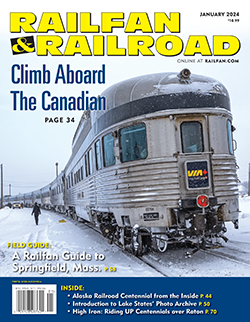 If I had to pick any decade to encapsulate the world of 20th century railroading, it would be the 1960s. But when do the sixties begin and end? If we mean dates on a calendar, this is easy, but if we think of the sixties as a distinct period of time in history, this becomes far harder to answer. Decades, after all, are fairly arbitrary — it is not as if a switch is flipped on New Year’s Day, changing everything.
If I had to pick any decade to encapsulate the world of 20th century railroading, it would be the 1960s. But when do the sixties begin and end? If we mean dates on a calendar, this is easy, but if we think of the sixties as a distinct period of time in history, this becomes far harder to answer. Decades, after all, are fairly arbitrary — it is not as if a switch is flipped on New Year’s Day, changing everything.
Historians struggle with this problem a lot, and some talk about “long” time periods, fuzzing up the borders a little to better define a period of time. For the 1960s, then, we might think of the recession of 1958 as a possible starting point, and the collapse of Penn Central in 1970 (or perhaps the formation of Amtrak in 1971) as the markers of this era.
Thought of this way, the “long” sixties become a truly evocative time in railroading. At the period’s beginning, it was still possible to see the waning days of steam locomotives on the high iron of Union Pacific, Norfolk & Western, and Canadian National. The iconic freight car was still a 40-foot boxcar, with some wood-sided examples still hanging on in revenue service. Reefers cooled with ice remained commonplace, and passenger service was an expectation and not the exception along almost any main line. By the end of the decade, all this would change with the arrival of second-generation diesels, nationalized passenger rail, and vast, consolidated rail systems born out of corporate mergers. Freight cars went from the “standard” forms of the steam age to something more recognizable to modern eyes, such as three-bay covered hoppers, “high-cube” plug door boxcars, and hulking chemical tanks. Contrast, in the sixties, ran high.
Both then and now, many saw this as a period of loss. Unquestionably, there were fewer steam engines and passenger trains at the end of the sixties than at the beginning. There were also, thanks to mergers, fewer companies. As but one example, storied names such as Great Northern; Northern Pacific; Chicago, Burlington & Quincy; and Spokane, Portland & Seattle were, thanks to their 1970 merger, combined under the fresh, crisp, green paint of Burlington Northern. For a time, the new combined systems of the period (Erie-Lackawanna in 1960, Seaboard Coast Line in 1967, and Penn Central in 1968, to name a few) brought new names and graphic identities to the railways, sitting alongside the thousands of cars and locomotives still bearing traditional names. This diversity, however, was also a kind of loss, as each of the old names and emblems and paint schemes slowly faded, rusted, and decayed.
As Managing Editor Otto Vondrak remarked to me recently, “The 1960s are now as quaint as the 1920s once seemed to us in the 1980s.” Yet it is in the sixties that the world of today’s railroading became recognizable. The locomotives of the era, especially those produced by the Electro-Motive Division of General Motors, became so ubiquitous that hundreds of them remain in service even now, a half-century later. Most of the types of freight cars we see on the rails today owe their forms to the sixties, and even Amtrak, formed in 1971, is a product of the era. The sixties, then, are simultaneously familiar and exotic, within easy reach and distantly distant. If the 1950s represented the golden age and the last gasp of steam, and the 1970s were the nadir of gritty, hard-scrabble railroading, then the 1960s are the paradox that links them — tantalizingly different and fascinatingly familiar at the same time.
Alexander Benjamin Craghead is a transportation historian, photographer, artist, and author.



